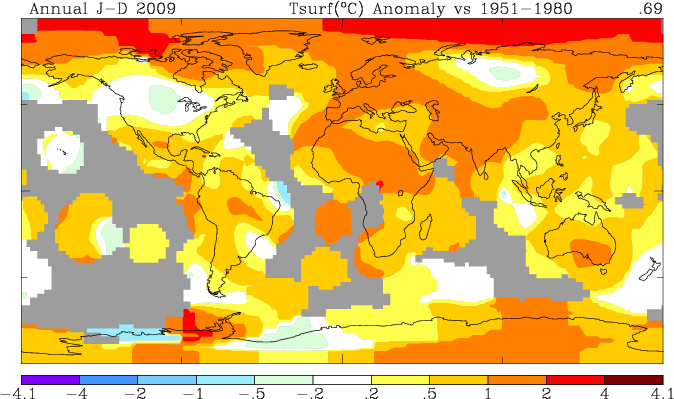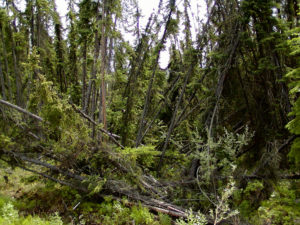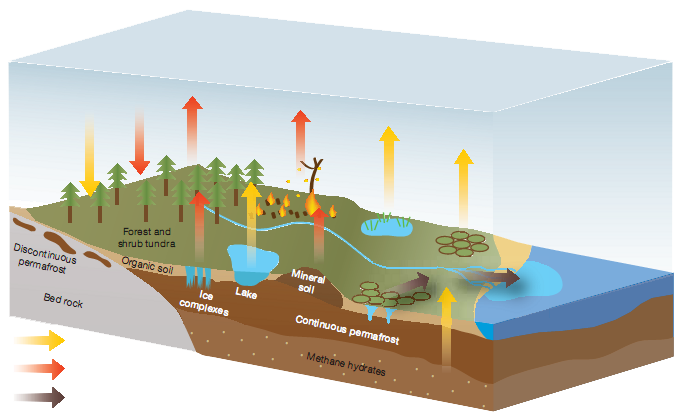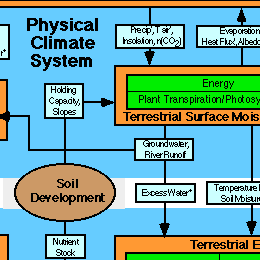We tend to think of climate change as something that happens very slowly, over a very long time. We further tend to think that its more serious effects are still decades away. We are learning now that both assumptions are wrong. While scientists are getting a firmer understanding of how the climate works and how sudden and self-sustaining climatic changes can be triggered, it is becoming clear that climate change is in fact not decades away. For many, it is already here.

Climate change is neither gradual nor uniform
It is well known that some years and even decades are cooler, warmer, wetter or drier than others. The weather can behave in fits and starts and in generally unpredictable ways, and two years in a row are never the same. This common knowledge notwithstanding, the snowy winter of 2010 on the east coast of North-America led to a new barrage of mockery of the idea of climate change from cable news and right-wing pundits.
Paradoxically, cold weather can be as much an indicator of global warming as hot weather. Global warming can mean that your city and region becomes warmer or colder, wetter or drier, or perhaps experiences more dramatic differences between summer and winter. What matters is that global warming changes how the climate behaves. For some, global warming can mean cooler temperatures. In reference to the normal human body temperature, global warming seems small: the global average temperature has increased by just under 1°C (1.5 °F) since the beginning of the Industrial Revolution, around 1850. Most of us would not even be able to notice that difference on our skin, yet it is enough to drive distortions of long-established weather patterns. Scientists predict that one of the most noticeable effects of global warming will be more ‘abnormal’ weather, in the form of more severe storms, more heat waves and more torrential downpours. Unfortunately, it can also mean permanent changes for some regions, such as more arid conditions, which could drive changes in agricultural productivity. Global warming is certainly not invalidated because a few American cities were buried in snow one winter. Residents of these cities should instead ask themselves: is the weather getting more temperamental?
The Arctic is a hotspot for climate change

There are, however, places on the planet where global warming is having direct, observable effects. Global warming is felt more keenly at the top and bottom of the world, and the ground that was erstwhile frozen beneath the surface layer all year is now thawing in the summer months, so that trees and houses lose their firm foundations. As a result, roads are disappearing into the ground, houses are falling in on themselves and trees are leaning over, as if in a drunken stupor.
Arctic amplification, as the phenomenon of Arctic warming is called, is making mince meat of official climate change forecasts, which say dire effects of global warming should still be years away. For example, according to the latest IPCC assessment report from 2007, we should not expect the Arctic ice cap that covers the North Pole to be gone until some time between 2070 and 2090. No need to worry, in other words, we should still have plenty of time to bring our carbon emissions under control; enough time to make it a soft landing.

Except nature isn’t following the official script. In 2007, scientists could only look on in alarm as the Arctic ice cap receded to its smallest size ever recorded, 39.2 per cent smaller than the 1979 – 2000 average, obliterating the previous record set only two years before. Since satellite observation started in 1979, the eyes-in-the-sky have revealed a steady decline in the minimum ice cover at the end of the summer melting season, varying a little year over year. But suddenly, in 2007, the bottom dropped out of the scientists’ graph. How could so much ice vanish in a single melting season?
Scientists discovered that part of the reason why the melting was suddenly so dramatic was that the melting process, once started in earnest, reinforces itself. Human interference is no longer needed to keep the process of melting going. This is called a positive feedback effect, and the climate system is full of them. In the Arctic Ocean, the specific mechanism is that the melting sea ice reveals the ocean underneath. Where ice had previously worked like a giant mirror, reflecting most of the light and heat that hit it, the dark ocean worked like a sponge. This ice-albedo effect, as scientists call it, heats the Arctic Ocean, and when the ocean gets warmer, more ice melts, which exposes yet more ocean to the Sun.
If the trend continues, the ocean over the North Pole may be ice-free in the summer decades earlier than anticipated. That is bad news for the hapless polar bears — but it is bad news for us as well. Thanks to the ice-albedo effect, glaciers everywhere on the planet act like air-conditioners for the Earth, reflecting significant amounts of infrared radiation — or heat — from the sun. As they melt, they remove an important back-stop that has allowed the Earth to keep some of its cool. In fact, without the glaciers and ice caps, the Earth would be a warmer place to begin with.
Tipping points are lurking around the corner

But the ice-albedo effect is only one feedback effect in the climate system. Melting sea ice could become a gateway to a far more insidious threat, coming from the thawing soils of the high north. For millennia, the permafrost has safely locked away billions of tons of carbon in the soils, lake beds and sea floors of the Arctic. Both carbon dioxide and methane, deposited in the ground a long time ago and removed from the carbon is now being released from the thawing permafrost at increasing rates.
Methane is a particularly big worry because it is an extremely potent greenhouse gas, with about 25 times the warming potential of carbon dioxide over the long term (and much highe warming potential over the short term). Fortunately, its airborne lifespan is far shorter, with a half-life of just seven years (meaning half of emitted methane is no longer in the atmosphere after that time period).
There is, however, enormous amounts of methane trapped in methane hydrates on the bottom of the Arctic Ocean. Methane hydrates — also called methane clathrates — are a very peculiar substance formed by water and methane under high pressure and low temperatures. It looks like ice, but put a match to it, and you can set it on fire. However, it is only stable as long as it stays frozen, and with the Arctic Ocean getting warmer, scientists are worrying that the water/methane bond will break down, releasing the methane into the atmosphere.
Even worse, if this process starts in earnest, it too could trigger a feedback effect, since more emissions will trigger more warming, and hence more melting. This could become what scientists call a threshold, or tipping point. Once a tipping point is crossed, the force of change becomes so great that it becomes unstoppable — it becomes self-sustaining — as the climate pivots over onto a new and unknown “normal.” With hundreds of millions of tons of methane added to the greenhouse effect, the planet could become several degrees warmer in a very short time, perhaps as little as a decade. We would be relegated to being passengers on a wild ride of rapid and historically unprecedented global warming, only able to look on, helplessly, as species would go extinct, deserts would spread, oceans would rise and the weather would be going haywire all over the place. There may be no going back if we cross a tipping point.
We also know of other potential tipping points in the ocean currents (the Gulf Stream could shut off, as it has before), the Greenland ice sheet (which could start melting and sliding into the sea uncontrollably, raising sea levels worldwide by around seven metres), the Amazon rainforest (which could whither and burn under prolonged droughts), or the life-giving Indian monsoon (which climate models suggest would change its size, timing and path).
Uncertainty is not a cushion (or why we’re not lost yet)

Tipping points are extremely concerning because we might not see them coming; a slight change in climate might be enough to push a system across the threshold. This is extremely complex climate science, involving countless different processes and systems that all interact, as well as cosmic variables like the Earth’s rotation around the Sun and the Sun’s activity itself. Ocean temperatures in the Arctic depend on currents, the ice-albedo effect and many other climatic variables. For scientists, making accurate, long-term predictions under such conditions becomes nigh on impossible; informing society about the effects of global warming on local climates or even how much warming we might experience is completely out of the question. This is why global warming estimates still cover an enormous range, from 1.1 up to 6.4°C (2.0 to 5.2°F), and haven’t changed in three decades.
With all this, you may be thinking that it is just another example of climate fear-mongering, contrived to attract research money, propel scientific careers or even expand state control over society. Or perhaps you say that the uncertainty surrounding the issue is too high to justify the high costs of emission reductions. If this is your opinion, I can’t convince you otherwise. But I can say that risk involves not just the chance that something may happen, but also the consequences of the event. There may be no way of compensating for and adapting to the effects of dangerous climate change — lost species would be lost, melted glaciers could only regrow over a really long time, if at all. Uncertainty should not be an excuse not to act — it should be precisely the opposite.
I can also say that we shouldn’t be too alarmed, because these tipping points are not a foregone fact (I sure hope they’re not!). Nature may be more robust than scientists think. But even if it is not, if we act quickly and resolutely to cut emissions, we may never reach the temperatures required to cross a tipping point. The longer we postpone serious action, however, the farther we push the climate system and the more likely dangerous climate change becomes. Temperatures will continue to rise for decades even if we cut carbon emissions to zero today. And if we continue with business-as-usual, dangerous climate change is virtually assured.
Sources
- WWF Arctic Feedback Report. WWF, 2009. (See article)
- Arctic Climate Change Impact Assessment. Arctic Council, 2006.
- IPCC 4th Assessment Report. Intergovernmental Panel on Climate Change, 2007.
- “The central role of diminishing sea ice in recent Arctic temperature amplification.” Screen & Simmons, Nature, 2010.
- “Can we still avoid dangerous human-made climate change?” James Hansen, Social Research, 2006.
- “Abrupt climate change.” Alley et al., Science, 2003.
- …and there are many more!

